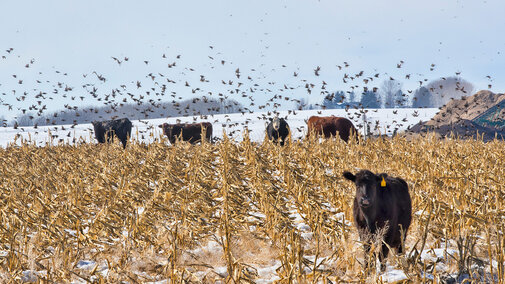Grazing Through Snow and Ice
While the moisture this year is welcome, winter precipitation can bring challenges to animals grazing crop residues or stockpiled range. Not all snow is created equal, however, and impacts can vary.
Just how much snow or ice can be a problem for animals grazing is debatable. This back and forth can mostly be attributed to two factors: the forage itself and precipitation we receive. The height and structure of forage is a huge part of availability under snow or ice. Taller and fluffy forages like stockpiled pasture or windrowed grass are easier for animals to reach under snow and ice.
When it comes to precipitation, a heavy, wet snow will be harder to dig through than dry fluff. However, even drier snow in a large amount will result in the bottom portion getting compressed and more difficult to dig through. Crusting of the top layer after sunny days or warm temperatures is a concern as well. Compression and the forming of a crust makes animals trying to dig through for a bite have to work that much harder.
With ice, thickness and length of time it is maintained are the two factors to keep in mind. An inch of ice that melts in a day or two after warm temperatures can have less of an impact than one-fourth inch that sticks around for three or four days.
So, what is the level we need to watch for? Every animal is going to be a bit different; however, I like the six and one-fourth inch rule. Six inches of snow or one-fourth inch of ice, and animals have to work harder to eat. At this point, we need to start watching animal condition and be ready to supplement, especially when temperatures drop. With colder temperatures, animals require more and more energy just to meet basic metabolic needs.
Effects of Cornstalk Baling and Windrowing Techniques
By Brad Schick
Baling cornstalks is becoming more and more common. Cornstalks, or corn residue, is a valuable option for beef producers to reduce feed costs. Advancements in harvesting technology to increase the feeding quality of the residue bale have arisen due to increased utilization of corn residue as a marketable product for feed, bedding and fuel. How those bales are windrowed and baled affects their quality and nutrients leaving the field. For one ton of corn residue, those nutrients are 17 pounds of nitrogen, 4 pounds of phosphate, 3 pounds of sulfur, and 34 pounds of potash. More residue removed means more nutrients to be replaced.
Trials at UNL examined the EZ bale and New Holland Cornrower systems. The EZ bale system is where the combine tailings are dropped in a windrow behind the combine, and then the windrow is baled, including the tailings and two rows of stalks. This system replaces the raking step. The traditional rake-and-bale system removes about two-thirds of the residue, while the EZ bale removed about one-third.
Another trial looked at the New Holland Cornrower system, wherein an attachment to the cornhead cuts two, four, six or eight rows of stalks and places them in a windrow where the tailings are dropped. This replaces the raking step. When eight rows are windrowed, the yield is similar to rake and bale, and when two rows are windrowed, the yield is similar to the EZ bale system.
Growing calves fed bales that were raked and baled behind the combine gained 2.11 pounds/hd/day while baled behind a cornrower head with two rows chopped gained 2.34 pounds/hd/day. This was due to less corn stem within the bale. The EZ bale feed resulted in gains of 2.19 pounds/hd/day.
There are several systems to bale corn residue a particular way. Be sure to know the pros and cons from a feed, fertilizer and performance standpoint.

